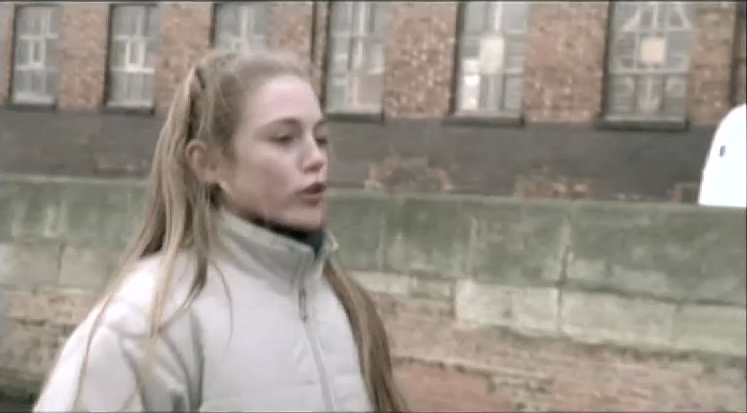Mise-en-Scene
Sound
 |
| The films main character seen as a silhouette against the bright sky behind her. |
Representation
The spectator is first introduced to the films main character through a low angle long shot of her standing in a field against a brightly lit background. The blue and white colours of the sky behind her cause her to become a silhouette in the frame, and she can be seen singing and performing a dance routine to the song 'I'm not that innocent.' The setting then cuts to a walkway alongside a canal where derelict and boarded up houses can be seen at the edge of the water. This suggests very little wealth in the area that our protagonist lives when partnered with the dull greys and browns of the buildings. She begins talking, and a harsh Manchester accent can be heard. The spectator is unable to assume her class and status simply from the way that she talks, but the harshness of her accent, the fact that she doesn't pronounce her 'T's' and 'Th's' and her limited vocabulary, substituting words she does not know for 'thingy' make is easier to guess that she is perhaps working class. However, she later on talks about how her father doesn't have time for her because he is 'looking for work' and how her mum lives off 'Dodgy burgers and knock off Larger' which suggests that actually her parents do not work at all, and could arguably be categorised as underclass as opposed to working.
 |
| Medium shot of protagonist walking along the canal path. |
During the shots by the canal path, a handheld camera is used and mostly a low angle medium shot. This gives the impression that she is talking to someone, perhaps a friend, and the position of the camera being next to her but slightly in front results in the spectator feeling as though she is directly addressing them, and therefore feel more involved in the shot. The film mainly consists of the girl talking about various events that have happened in her life involving her friends and family. When a memory is referred to, the scene cuts and a flashback of the event follows.
The spectator is first introduced to her mum and her little sister in a memory of the three out shopping on the street. She is in the foreground of the shot, while the other two are in the background in a deeper depth of field. Her mum can be seen scratching at a scratch card, which emphasises the family's lack of money and arguably their desperation. However, the little girl can be seen jumping up and trying to get her mothers attention, which paired with the fact that the main character is separated from the two could be a representation of the relationship between the three. The mum says 'hold on a minute' to the youngest daughter when she attempts to get her attention, which suggests that she perhaps doesn't have the time for her, and possibly see's her as a nuisance. The fact that the main character has distanced herself from her mum suggests that this is something she already knows, and has come to terms with. The first reference the spectator has of her father is her mum referring to him as a 'bastard,' which reinforces the idea of the protagonists unstable home life. Disputing parents is common throughout all classes, and separated families just as much, but with both sides struggling to find work and money, the main character being part of the underclass is enhanced.
No comments:
Post a Comment